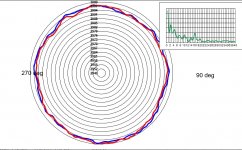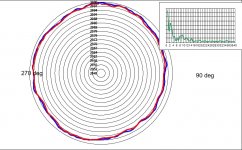One of the tutorial videos for Capstan implies that an intelligent approach to programme music is used to determine reference key/pitch and musical expression such as vibrato. If so, our 3kHz test tone would hardly be a fair test, methinks.
Nevertheless, the SW looks to have made an attempt to correct LF pitch errors, resulting in a very different LF spectrum that looks sort of quasi-random in the time domain, but overall probably has the same magnitude of pitch variation as the original.
But it pretty much nailed the 0.55Hz variation..........
LD
Nevertheless, the SW looks to have made an attempt to correct LF pitch errors, resulting in a very different LF spectrum that looks sort of quasi-random in the time domain, but overall probably has the same magnitude of pitch variation as the original.
But it pretty much nailed the 0.55Hz variation..........
LD
As stated earlier, that's a different software. It would not work on a recording without a bias tone, which Capstan will.I recall seeing the news blurb when Capstan was announced, the idea was it locked onto the ultrasonic tape bias signal, which actually gets recorded and plays back at 15IPS tape speed.
I have discovered that my STD-305 suspension has shifted again, so the suspended platter is rubbing against the plinth. This is a suspension even more tricky to setup than a LP12.Using the tools I have - FFT - I took a look at the original and the fully corrected files and the low end is almost identical. Up at 3K and its harmonics is where we see the real difference...
There is vibration from beneath from a computer fan, which might be exciting the arm
No, you can see the eccentricity on HFS75. I was going to record my Ellipson when I noticed the sprung platform had shifted.Do you think that was causing the periodic slowdown?
I am trying to set up the deck properly first, but no instructions anywhere for the STD. I suspect lumps of soft foam inside the springs were being used to offset the springs against the pillar bolts. 35 years has done its work on the foam
The foam has hardened. more surprising I am still using the original belt, although I am OCD about keeping it talced and away from oil.
Anyway, I will report back with fresh tracks when this deck is sorted
Anyway, I will report back with fresh tracks when this deck is sorted
@LD I've started to explore the scientific packages that come with Python. The spectrogram routines have a lot of variables to set. Do you have any good FFT lengths, overlaps, and windows that would make a good starting point?
The radial plotting is built in and you can generate exactly the same plots you show with about 10 lines of code.
The radial plotting is built in and you can generate exactly the same plots you show with about 10 lines of code.
@luckythedog, I'd be interested in a polar plot for this one, if you'd be so kind:
Dropbox - 20170422-T003_WF_1.wav
Dropbox - 20170422-T003_WF_1.wav
Sure, here it is. Very good too, perhaps near as good as it gets.@luckythedog, I'd be interested in a polar plot for this one, if you'd be so kind:
Dropbox - 20170422-T003_WF_1.wav
What rig is it ?
LD
Attachments
Thanks! That's one of my Technics SP-10 MK3. I may have another sample in a few weeks that hopefully shows some improvement.
Perhaps this one if it's not too much:
Dropbox - MK4_XG-7001_WF_1.wav
The second one is an SL-1200 GAE, and this is an SL-1200 MK4. All three with the same test record.
Dropbox - MK4_XG-7001_WF_1.wav
The second one is an SL-1200 GAE, and this is an SL-1200 MK4. All three with the same test record.
Interesting. So it's not just the big block V8 of the motor world 🙂
As someone used to wimpy motor belt drives getting a 10kg platter to speed in a 1/4 revolution still makes me want one just for that party trick!
As someone used to wimpy motor belt drives getting a 10kg platter to speed in a 1/4 revolution still makes me want one just for that party trick!
No, it's definitely not. Same important bits as the SP-02, for which they claimed 0.0034% W&F, though via measuring the motor FG.
Sure - if I understand it, this is the SL-1200 GAE.
Very nice too.
What arm/cart for these files, JP ?
LD
Attachments
- Home
- Source & Line
- Analogue Source
- Turntable speed stabilty

